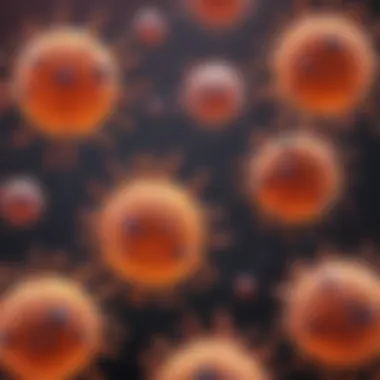Exploring the Curable Rate of Leukemia: Insights and Advances


Intro
Leukemia, a complex group of blood cancers, presents a unique challenge to medical science. This article delves into the intricate factors influencing the curable rate of leukemia. By understanding the underlying principles, current research, and treatment advancements, one can grasp the complexities associated with leukemia treatment.
The curable rate is not a fixed entity; it fluctuates based on several variables, including leukemia subtype, patient demographics, and treatment responses. The insights presented here aim to provide a well-rounded perspective on these dynamics, showcasing both progress and existing challenges in leukemia care.
Prologue to Leukemia
Understanding leukemia requires a careful examination of its nature, prevalence, and symptoms. This is crucial for both academic research and practical treatment approaches. The fundamental knowledge of leukemia sets a context for evaluating its curability. This section will clarify what leukemia is, its incidence rates, and the main symptoms that lead to diagnosis. Each element is essential; knowing the definition helps in differentiating types, while statistics can illustrate how widespread the condition is. Moreover, recognizing symptoms aids in early detection, a key factor in improving treatment outcomes.
Definition and Classification
Leukemia is a type of cancer that affects the blood and bone marrow. It involves the uncontrolled production of abnormal white blood cells. These cells crowd out normal cells and hinder the body's ability to fight infections and produce healthy blood components. There are several classifications of leukemia, primarily categorized into acute and chronic types, as well as lymphocytic and myeloid.
- Acute Leukemia: This type progresses quickly and requires immediate treatment.
- Chronic Leukemia: This type develops slowly over time, allowing for a range of symptoms that may go unnoticed in the early stages.
- Lymphocytic Leukemia: It affects lymphoid cells, while myeloid leukemia impacts myeloid cells.
This classification is vital as it directly influences prognosis and treatment paths. Knowing the specific type supports targeted interventions, often improving curability.
Prevalence and Statistics
Leukemia is not a rare cancer. Each year in the United States alone, approximately 21,000 new cases of leukemia are diagnosed. Its prevalence varies by subtype, with Acute Lymphoblastic Leukemia being more common in children. On the other hand, Chronic Myeloid Leukemia predominantly affects adults.
- Acute Lymphoblastic Leukemia: Most common in people younger than 20.
- Acute Myeloid Leukemia: More frequent in older adults.
- Chronic Lymphocytic Leukemia: Usually seen in those over 70.
- Chronic Myeloid Leukemia: Typically affects adults between 45 and 64.
This data helps in identifying demographic factors that may influence incidence and survival rates.
General Symptoms and Diagnosis
Symptoms of leukemia can vary significantly based on the type and stage of the disease. Common symptoms include:
- Fever and chills
- Frequent infections
- Weight loss
- Fatigue
- Swollen lymph nodes
Diagnosis typically involves blood tests to identify abnormal blood cell levels. Additional diagnostic methods may include bone marrow biopsies. Early diagnosis improves treatment efficacy significantly.
"Leukemia often presents with mild symptoms that can be mistaken for other illnesses, leading to delayed diagnosis."
"Leukemia often presents with mild symptoms that can be mistaken for other illnesses, leading to delayed diagnosis."
Understanding these symptoms is crucial for timely intervention, which ultimately affects curable rates.
Understanding Curable Rates
Understanding curable rates in leukemia is essential for comprehending the disease's landscape. It sheds light on how effective treatments are and helps in predicting patient outcomes. Curable rates are integral to gauging the advancements in medical science. Knowledge about these rates guides both healthcare providers and patients in making informed decisions. Additionally, it provides crucial insights into the efficacy of various treatment modalities as well as the potential for recovery.
Defining Curable Rates
Curable rates indicate the proportion of patients who achieve complete remission or result in a permanent resolution of their leukemia. This measure varies significantly depending on the type of leukemia. Acute lymphoblastic leukemia often shows higher curable rates, particularly in children, while chronic leukemias may fluctuate substantially depending on genetic factors. Each subtype of leukemia responds differently to therapies, which pivotal impacts their respective curable rates.
Curable rates can change over time, influenced by new treatment protocols and research. In general, the determination of what constitutes a 'cure' can involve a combination of clinical interpretations and patient experiences. Medicine's evolving landscape prompts a continuous reassessment of survival rates and treatment efficiency, making it essential for healthcare professionals to remain aware of these changes.
Factors Influencing Curable Rates
Several factors contribute to the variation in curable rates among leukemia patients. These include:
- Type of Leukemia: Different types have inherently distinct biological traits that dictate their responses to treatment.
- Age of the Patient: Younger patients typically display better outcomes when it comes to curable rates. Children, for instance, often have more favorable responses compared to adults.
- Genetic Mutations: The presence of specific genetic abnormalities can have a profound effect on how a patient responds to treatment, significantly influencing curable rates.
- Treatment Accessibility: Access to advanced treatments, including stem cell transplants, may vary. Limited availability can lead to disparities in outcomes.
- Health Status Prior to Diagnosis: A patient’s overall health and comorbid conditions significantly affect their recovery potential.
"The definition of curable rates in leukemia is not static. Improved treatment options continue to reshape what we consider a curable scenario."
"The definition of curable rates in leukemia is not static. Improved treatment options continue to reshape what we consider a curable scenario."


Recognizing these factors is crucial for developing personalized treatment plans that maximize the chances of achieving a cure. Understanding curable rates thus serves as a guide for both treatment strategies and clinical research, aiming to identify areas of improvement and focus in future therapeutic efforts.
Types of Leukemia and Their Curability
Understanding the different types of leukemia is essential. Each subtype has distinct biological characteristics, treatment options, and curability rates. This article section will ensure readers appreciate how these nuances influence patient outcomes. Knowledge of leukemia subtypes is crucial for students, clinicians, and researchers, as it shapes therapeutic strategies and prognosis assessments.
Acute Lymphoblastic Leukemia
Acute Lymphoblastic Leukemia (ALL) is one of the most common leukemias in children. It is characterized by the rapid growth of immature lymphocytes. The curable rate for ALL can be high, especially in younger patients. Recent studies suggest that treatment that combines chemotherapy and targeted therapy can lead to long-term remission.
Key factors influencing curability in ALL include:
- Age at diagnosis: Younger patients tend to have better outcomes.
- Genetic factors: Certain chromosomal abnormalities impact curability.
- Response to initial treatment: Rapid response often indicates a favorable prognosis.
Prognosis
The prognosis varies considerably. In children, the five-year survival rate exceeds 85%, while for adults, it generally falls between 40% to 50%. These statistics highlight the relevance of age and biological differences between adult and pediatric ALL cases.
Acute Myeloid Leukemia
Acute Myeloid Leukemia (AML) is another aggressive form that affects adults more frequently. This leukemia arises from the myeloid line of blood cells and progresses quickly. Unlike ALL, the curable rate for AML is lower, reflecting its complex nature.
Factors influencing curability in AML include:
- Patient's age: Younger individuals have a better chance of surviving.
- Genetic mutations: Specific mutations may respond better to treatment.
- Previous health conditions: Other health issues can complicate treatment.
Survival Rates
Data shows that overall survival for AML is about 25% to 30% over five years. However, targeted therapies and new drug combinations may improve outcomes. The ongoing research in this area is promising and necessary for elevating these figures.
Chronic Lymphocytic Leukemia
Chronic Lymphocytic Leukemia (CLL) typically progresses slowly. Patients may live for years without requiring treatment. While not typically referred to as curable, treatment can control symptoms effectively.
Key considerations for CLL include:
- Early stage versus late stage: Earlier treatment often leads to better management.
- Genetic assessments: Determining risk scores can assist in treatment planning.
Living With
The survival rates associated with CLL vary. Many patients live comfortably for decades with effective management, but complete remission is rare. Recent advancements in therapies are redefining how this leukemia is treated, leading to improved quality of life for many.
Chronic Myeloid Leukemia
Chronic Myeloid Leukemia (CML) is characterized by the overproduction of myeloid cells. The discovery of the BCR-ABL fusion gene has transformed treatment options. Targeted therapies, such as imatinib, have significantly increased remission rates.
CML factors that enhance curability include:
- Phase of leukemia: Early diagnosed CML generally has a better outcome.
- Response to treatment: Initial good response predicts better results long-term.
Long-term Perspective
Currently, the long-term survival rate for CML is over 70% due to advancements in molecular targeting therapies. Research continues to evolve, fostering exploration of new treatment avenues that may increase the curative potential of CML.
Understanding the nuances of each leukemia type is instrumental in improving treatment outcomes and patient management strategies.
Understanding the nuances of each leukemia type is instrumental in improving treatment outcomes and patient management strategies.
Advancements in Treatment Strategies
The landscape of leukemia treatment has evolved significantly over recent years. Advancements in treatment strategies have not only improved survival rates but also transformed the overall approach to managing this complex disease. Understanding these strategies is crucial for patients and healthcare professionals alike, as it informs decisions about care and treatment pathways. The integration of new technologies, research developments, and treatment methodologies plays a vital role in enhancing curable rates among patients with different types of leukemia.


Chemotherapy
Chemotherapy remains one of the cornerstone treatments for leukemia. This approach uses cytotoxic medications to target and eliminate rapidly dividing cancer cells. Treatment regimens often combine multiple drugs, which can enhance effectiveness while potentially reducing resistance. The choice of chemotherapy agents depends on the leukemia subtype. For example, Acute Lymphoblastic Leukemia often involves drugs like Methotrexate and Dexamethasone, while Acute Myeloid Leukemia may require different combinations such as Cytarabine and Daunorubicin.
"Chemotherapy can lead to significant improvements in a patient's prognosis when tailored to their specific leukemia subtype."
"Chemotherapy can lead to significant improvements in a patient's prognosis when tailored to their specific leukemia subtype."
However, chemotherapy is not without its challenges. Patients often experience side effects, including fatigue, nausea, and increased risk of infections due to blood count fluctuations. Healthcare providers closely monitor these reactions to adjust treatment as necessary, ensuring a balance between efficacy and tolerability.
Radiation Therapy
Radiation therapy uses high-energy rays to target and destroy cancer cells. In leukemia treatment, it might be employed in specific situations, such as preparing for a stem cell transplant or targeting localized areas of disease. Radiation can be particularly effective for early-stage leukemia that has not spread extensively. Its application often depends on the patient's overall condition and treatment goals.
While it can enhance treatment outcomes, radiation therapy comes with risks, including damage to surrounding healthy tissues. Decisions on its use should be made carefully, weighing the potential benefits against risks.
Stem Cell Transplantation
Stem cell transplantation offers a curative option for some patients, particularly those with aggressive forms of leukemia or who have relapsed after other treatments. This procedure involves replacing diseased bone marrow with healthy stem cells, which can regenerate blood cells. It can be an autologous transplant, using the patient's own stem cells, or an allogeneic transplant, using stem cells from a donor.
The timing of stem cell transplantation is crucial. Patients who enter remission after initial treatments may benefit significantly from this approach, as it can help prevent relapse. Nonetheless, the process is complex and has associated risks, such as graft-versus-host disease, which requires thorough consideration by the medical team.
Targeted Therapy
Targeted therapy has revolutionized the approach to leukemia treatment. This method focuses on specific molecular targets involved in the growth and spread of cancer. For example, the use of imatinib in Chronic Myeloid Leukemia targets the BCR-ABL fusion protein, providing effective control over the disease in many patients.
These therapies often lead to fewer side effects than traditional chemotherapy, making them a preferred choice in certain scenarios. However, not all patients may have the necessary genetic markers for these treatments, so comprehensive testing is essential to identify suitable candidates.
Immunotherapy
Immunotherapy harnesses the body's immune system to fight cancer. In the context of leukemia, treatments like CAR T-cell therapy have shown promising results. This approach involves modifying a patient’s T-cells to recognize and attack leukemia cells more effectively. Results have been particularly optimistic in Acute Lymphoblastic Leukemia, where many patients have experienced durable remissions.
As with other treatment strategies, immunotherapy is not devoid of risks. Patients may experience significant side effects, including cytokine release syndrome. Continuous monitoring and supportive care are vital components in managing these potential complications.
Role of Genetic Factors
Genetic factors are increasingly recognized in the understanding of leukemia and its curable rate. Several genetic components contribute to how individuals respond to treatment and their overall prognosis. This aspect is crucial for tailoring more effective therapies and understanding the variability in patient outcomes. Genetic mutations can dictate not only the likelihood of developing leukemia but also the potential success of specific therapeutic interventions. Therefore, a thorough exploration of these factors is essential for advancing treatment protocols and improving survival rates.
Genetic Mutations and Their Impact
Genetic mutations serve as fundamental drivers in leukemia pathogenesis and influence the curability of the disease. Common mutations such as those in the FLT3, NPM1, and TP53 genes impact cell proliferation and survival. For instance, mutations in the FLT3 gene are often associated with acute myeloid leukemia (AML) and generally lead to poorer outcomes.
These mutations can result in distinct leukemia subtypes, each varying in their response to different treatment modalities. Early detection of these mutations through advanced genetic testing can help guide treatment choices. For example, patients with FLT3 mutations can benefit from targeted therapies such as midostaurin, improving their chances for remission.
Moreover, genetic mutations can also affect the likelihood of relapse. Thus, recognizing these mutations can be vital for predicting long-term outcomes and determining the need for prolonged or intensive treatment measures.
Familial Patterns and Risks
Familial patterns have shown to influence the likelihood of developing leukemia. Certain genetic syndromes, such as Down syndrome and Li-Fraumeni syndrome, have elevated risks for various types of leukemia. There is often a heritable component that predisposes families to specific genetic mutations associated with leukemia.
While the rate of familial leukemia cases is low compared to sporadic cases, their presence underscores the importance of genetic counseling. Families with a history of leukemia may benefit from regular check-ups and proactive monitoring. Genetic testing can reveal if family members carry mutations that elevate their risks, enabling early intervention strategies.
Socioeconomic Factors and Disparities
The curable rate of leukemia does not solely depend on medical advancements or individual biology; socioeconomic factors play a crucial role. Disparities in healthcare access, treatment options, and outcomes are often tied to economic status, geography, and education. Understanding these factors can help identify the obstacles many patients face and promote equity in treatment. Addressing these disparities is vital for maximizing treatment efficacy and improving survival rates for all.
Access to Treatment
Access to treatment significantly shapes the outcomes for leukemia patients. Individuals in lower socioeconomic groups may face challenges such as:
- Limited availability of specialized care facilities
- Geographic barriers that require long travel for treatments
- Lack of awareness about available treatment options and clinical trials


These issues can delay diagnosis and treatment initiation, resulting in worse outcomes. Moreover, patients living in rural areas often need to travel to urban centers where advanced treatments such as stem cell transplants are available. In contrast, urban residents might find it easier to access these services, highlighting a clear disparity.
Equitable access can be improved through community health programs that provide education and resources, making treatment more accessible to underserved populations.
Insurance and Financial Considerations
Insurance coverage significantly impacts the ability to receive adequate treatment for leukemia. Many patients rely on private insurance or government programs, which may not cover all treatment costs. Key considerations include:
- Co-pays and deductibles that burden families financially
- Limited coverage for innovative therapies such as targeted treatments or immunotherapies
- Variations in state-level healthcare policies that affect insurance availability
Patients without insurance might delay essential treatments due to cost concerns, ultimately harming their chances for recovery. Alongside medical bills, many families experience indirect costs such as lost wages due to treatment time. These financial strains can lead patients to opt for less effective treatment alternatives or abandon treatment altogether.
"Healthcare is a right, not a privilege. Financial barriers should not dictate the quality of care a patient receives."
"Healthcare is a right, not a privilege. Financial barriers should not dictate the quality of care a patient receives."
Addressing insurance gaps and making therapy affordable can help bridge these disparities and enhance survival rates for all leukemia patients.
Future Directions in Leukemia Research
As treatment for leukemia continues to evolve, the significance of research in developing new modalities cannot be overstated. Investigating future directions in leukemia research aims to enhance the curable rates of various leukemia subtypes. The emphasis on innovative methodologies signifies a commitment to tailoring treatments and improving patient outcomes. This section delves into two pivotal areas: innovations in treatment modalities and personalized medicine approaches.
Innovations in Treatment Modalities
Recent advancements in leukemia treatment have emphasized the importance of innovative modalities. Clinical trials are crucial for evaluating the effectiveness of new therapies that could redefine standards of care. These innovations often incorporate interdisciplinary approaches, involving oncology, genetics, and immunology. Research has led to novel treatments such as CAR T-cell therapy and other targeted therapies that specifically attack leukemia cells, minimizing damage to healthy cells. This shift marks a significant improvement from conventional treatments that often resulted in harsh side effects.
"Innovative treatment strategies are transforming the landscape of leukemia therapy, offering new hope where conventional methods have fallen short."
"Innovative treatment strategies are transforming the landscape of leukemia therapy, offering new hope where conventional methods have fallen short."
Some key innovations in treatment modalities include:
- CAR T-Cell Therapy: A form of immunotherapy where a patient’s T cells are genetically modified to better attack leukemia cells.
- Targeted Therapy: Drugs designed to specifically target genetic mutations associated with different types of leukemia, leading to more effective treatment regimens.
- Combination Therapies: The use of multiple agents or treatment types to counteract resistance and improve effectiveness.
These modalities not only aim to enhance survival rates but also focus on improving the overall quality of life for patients during treatment. Evaluating long-term outcomes of these innovations remains an active area of research.
Personalized Medicine Approaches
Another crucial future direction is the implementation of personalized medicine in leukemia treatment. This approach considers the unique genetic profile of each patient’s leukemia to tailor treatment. The goal is to administer therapies that are more effective for individual patients based on their specific genetic markers.
Genomic sequencing plays a pivotal role in this area, allowing clinicians to identify mutations and abnormalities that drive leukemia in each patient. As a result, oncologists can choose the most appropriate therapies that target these specific characteristics. This can lead to:
- Increased Treatment Efficacy: By using treatments that directly address the genetic makeup of leukemia, the likelihood of a positive response improves significantly.
- Reduced Side Effects: Targeting specific mutations may minimize the adverse side effects associated with broad-spectrum treatments.
- Better Prognostic Tools: Understanding the genetic landscape of a patient’s leukemia permits more accurate predictions about disease progression.
The integration of personalized medicine is reshaping how health professionals approach leukemia, encouraging a shift from a one-size-fits-all model to a more nuanced and individualized strategy.
In summary, the future of leukemia research promises to bring forth significant advancements through innovative treatment modalities and personalized medicine. These directions not only offer hope for increased curability but also underscore the need for continued focus on research that addresses existing challenges in the field. As we move forward, it is essential to remain adaptable and embrace new findings to improve our understanding and management of leukemia.
Finale
The conclusion of this article encapsulates the essential elements concerning the curable rate of leukemia. It emphasizes the interplay of various factors that influence the outcomes for patients experiencing this disease. Understanding the curable rates is not just about statistics; it reflects the lived experiences of individuals and the ongoing work of researchers and healthcare professionals.
Summary of Key Findings
The findings discussed throughout the article shed light on several critical aspects:
- The curable rates of different leukemia subtypes vary significantly. For instance, Acute Lymphoblastic Leukemia demonstrates a higher curability compared to Chronic Myeloid Leukemia.
- Advancements in treatment strategies play a pivotal role in improving survival rates. Innovations like CAR-T cell therapy and targeted therapy have shown promising results.
- Socioeconomic factors can impact access to treatment, thus contributing to disparities in curability rates among different demographic groups.
- Genetic factors influence treatment responses and outcomes, making personalized medicine a key area for future exploration.
These points underscore the complexity of leukemia treatment and the importance of a multifaceted approach in understanding curability.
Outlook for Future Research
Looking ahead, the future of leukemia research appears promising. Key areas for exploration include:
- Innovative Treatment Modalities: Continued development of targeted therapies and immunotherapies will likely lead to improved outcomes for patients.
- Genetic Research: Understanding genetic predispositions and mutations can provide insight into tailored treatment plans that could enhance curability rates.
- Health Disparities: Investigating and addressing the socioeconomic factors that hinder access to treatment will be crucial in equalizing outcomes for all patients.
- Long-Term Survivorship: Research into the quality of life and long-term effects of leukemia treatments remains vital as more patients achieve remission.
Overall, the conclusion highlights that while progress has been made, continuous efforts in research and treatment innovations are necessary to improve the curable rates of leukemia and address the challenges that persist.







